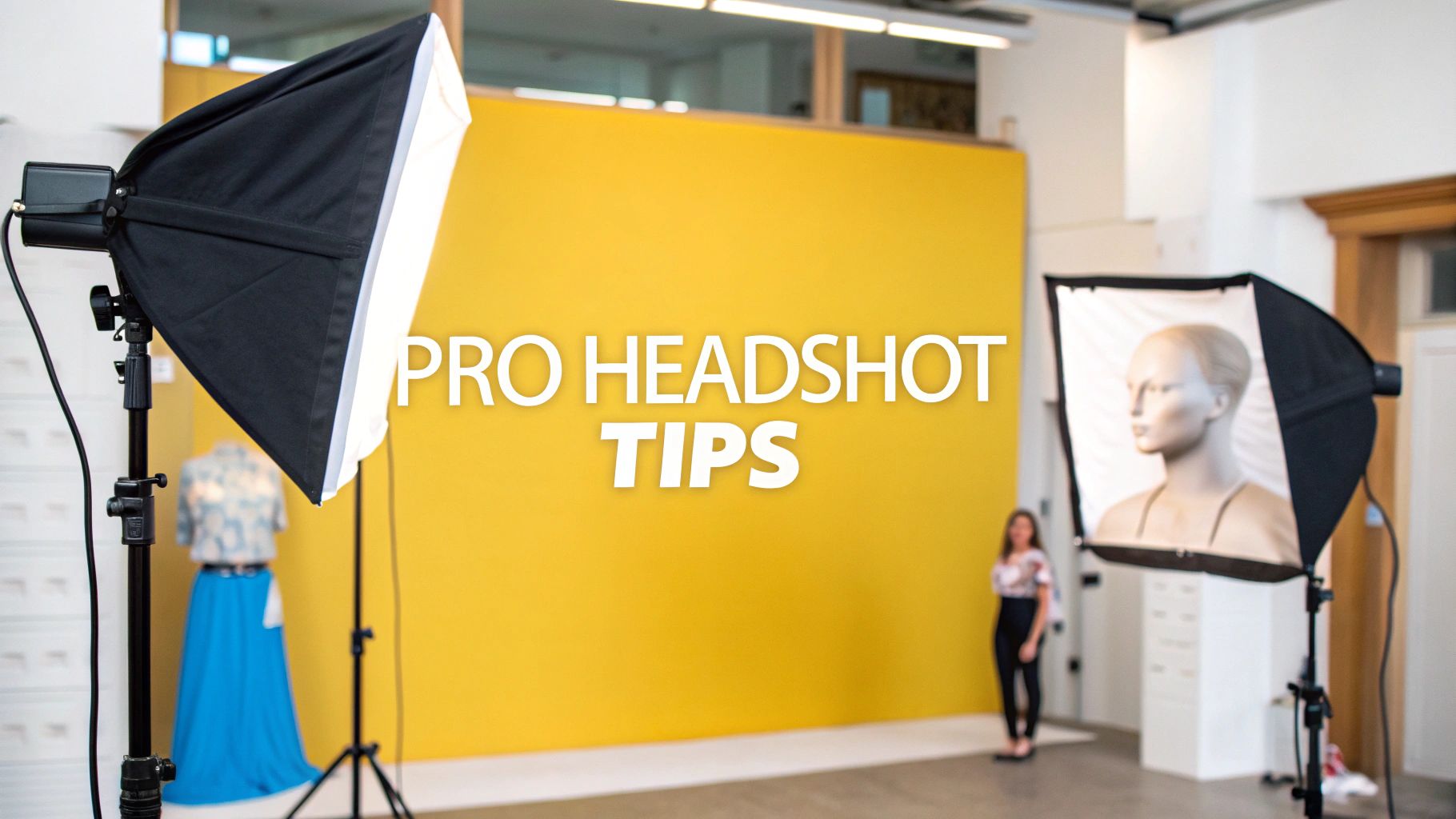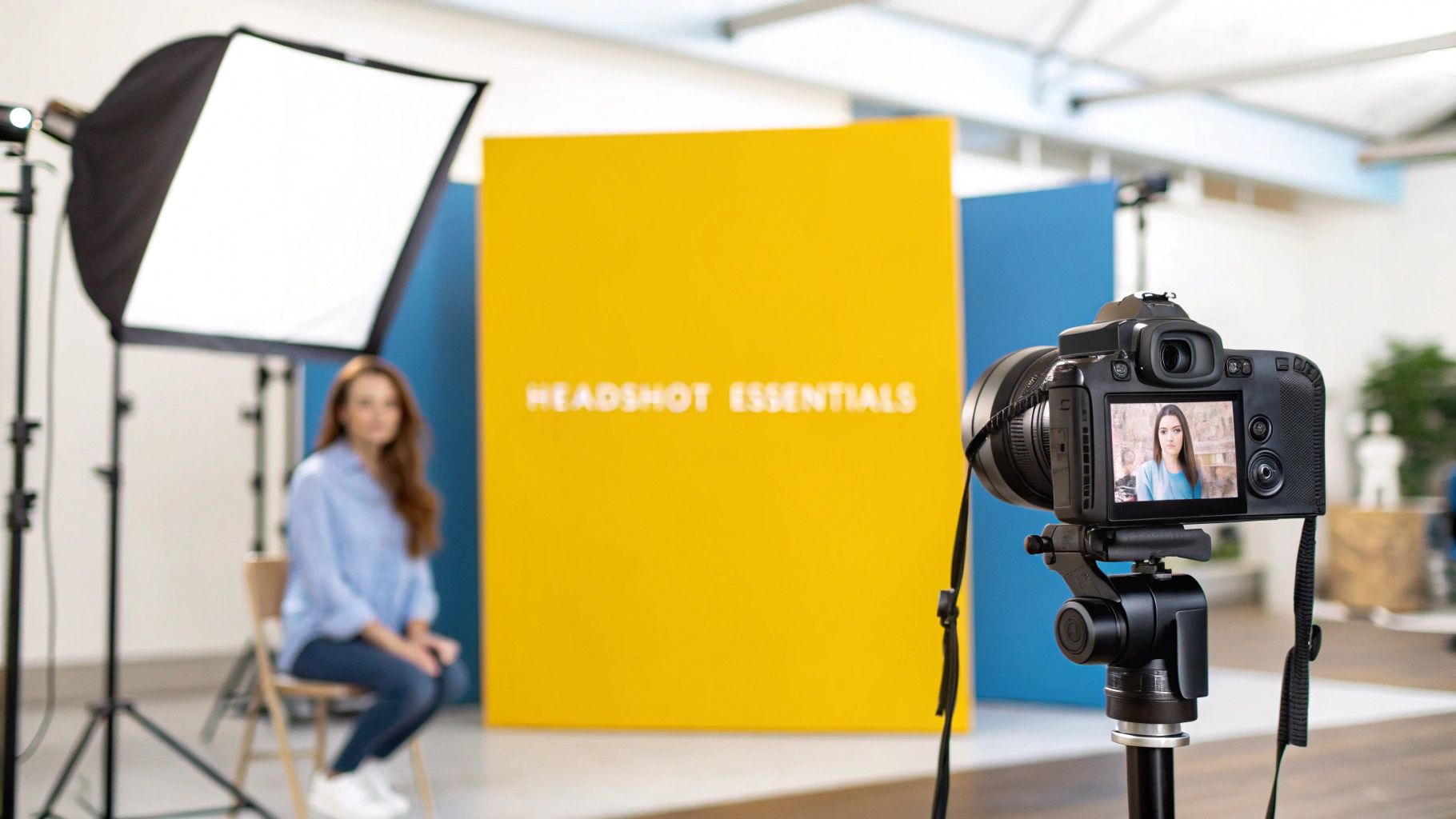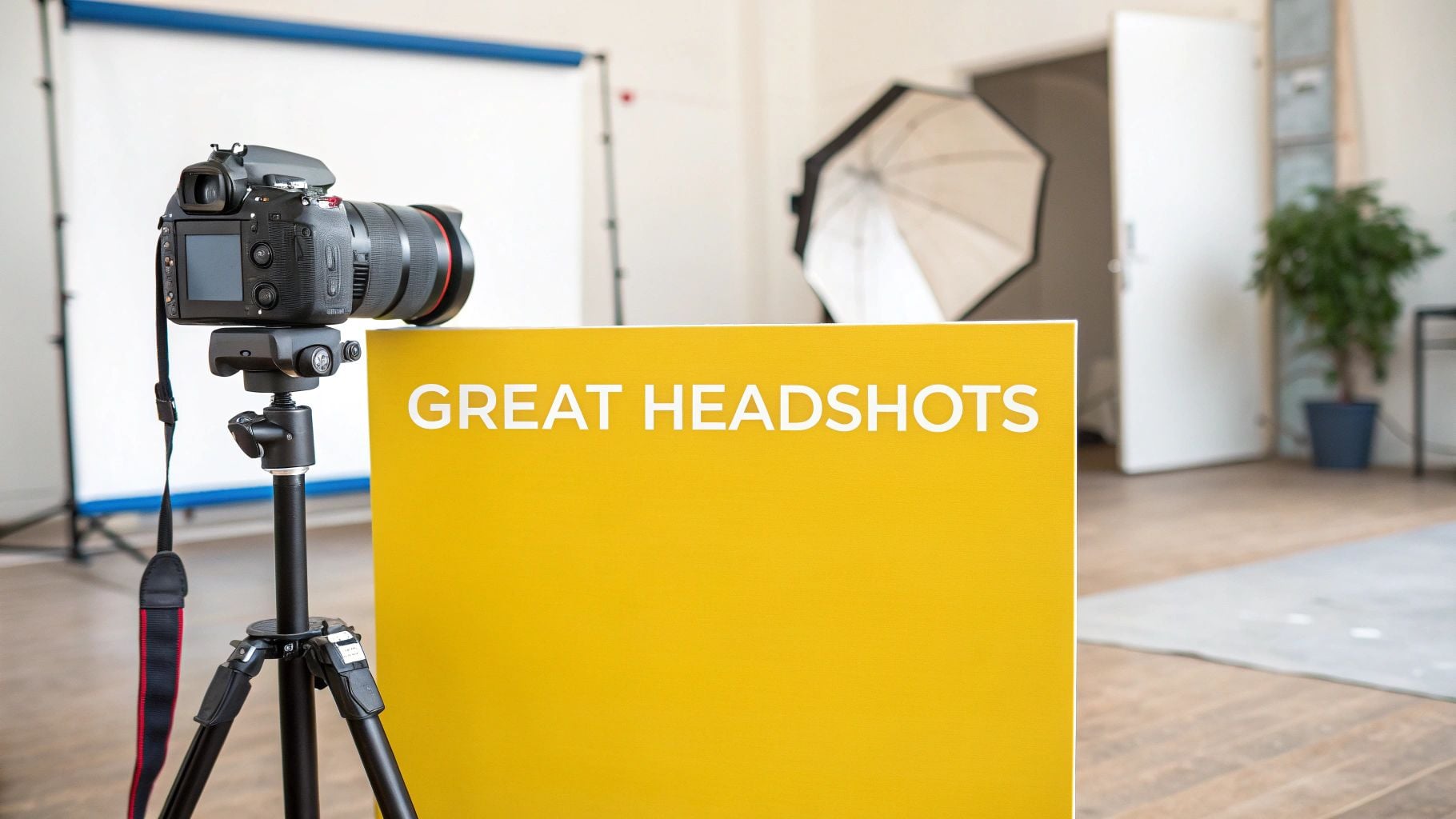In today's global professional environment, your headshot is more than just a picture; it's a key part of your personal brand. Before a potential employer reads your resume or a new client reviews your proposal, they often see your photo. This single image serves as a crucial first impression, conveying confidence, competence, and professionalism. Understanding how to create an image that works for you is an essential part of modern career management. For anyone serious about building an online presence, mastering effective strategies for personal branding begins with a compelling and professional portrait.
This guide provides actionable tips for headshots for professionals, designed to simplify the process and help you achieve exceptional results. We will break down the essential elements that contribute to a powerful image, covering everything from lighting and attire to posture and expression. We'll also explore how both traditional photography and modern solutions, including AI-generated headshots, can help you achieve a studio-quality look. Whether you're a recent graduate, an established executive, or a remote worker, these insights will help you produce a great headshot that authentically represents your professional identity.
1. Understand the Importance of Good Lighting
Proper lighting is the single most important element that separates an amateur snapshot from a professional headshot. It creates dimension, eliminates distracting shadows, and highlights your best features. Professional lighting ensures your face is evenly illuminated, making your skin look smooth and your eyes bright and engaging. This is a primary reason why professional photos, whether taken in a studio or created using advanced AI, have a polished and trustworthy feel.
The Power of Controlled Light
The goal is to use soft, diffused light that is flattering. Unlike the harsh, direct light from a camera's built-in flash or overhead office lighting, professional setups use tools to soften and direct the light source. This technique sculpts your facial features, adds a professional quality, and ensures the final image is crisp and clear.
Think of the impactful headshots of industry leaders you see on LinkedIn. They consistently use sophisticated lighting, like the classic three-point system, to project confidence and approachability. This isn't just about brightness; it's about strategic illumination.
Setting Up Your Lighting
Achieving professional results requires a methodical setup. To help visualize this, the infographic below illustrates the standard three-point lighting process used by photographers.
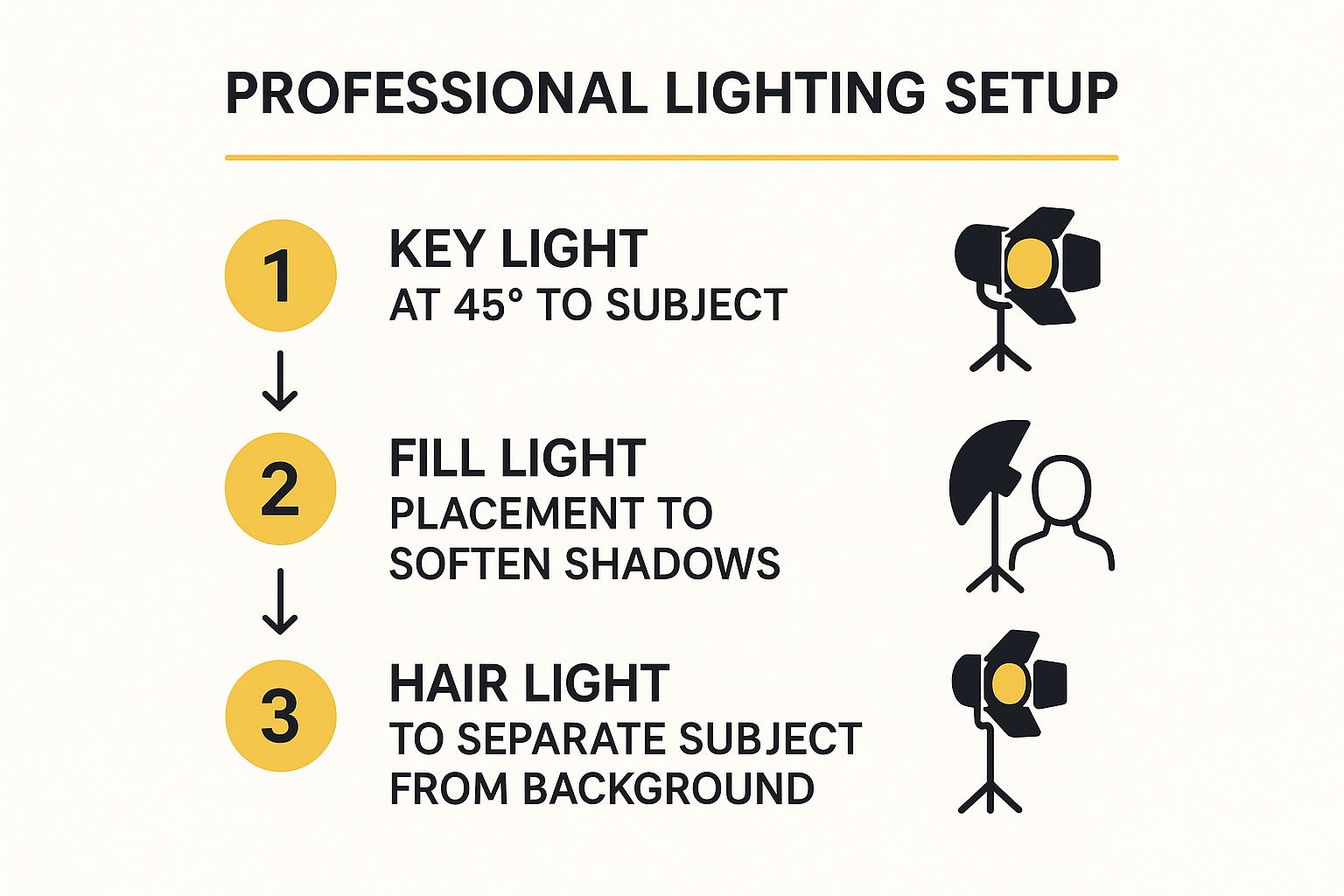
This process shows how each light source plays a distinct role in shaping the final image, from primary illumination to adding depth and separation.
If you’re working with a photographer, understanding this setup helps you collaborate effectively. For those considering DIY options, here are some practical tips:
- Key Light: Use a large, soft light source as your main (key) light. Position it about 45 degrees to one side of your face and slightly above eye level to create soft, flattering shadows.
- Fill Light: Add a second, less powerful light source or a reflector on the opposite side to soften the shadows created by the key light. This ensures your entire face is visible and reduces harsh contrast.
- Hair Light: Place a light behind and above you, angled down. This subtle light separates you from the background, adding depth and a professional finish to your portrait.
For a deeper dive into how different lighting setups can dramatically change the mood and quality of a portrait, this video provides excellent visual examples.
2. Choose Appropriate Professional Attire
Your clothing is a powerful form of non-verbal communication in a professional headshot. What you wear frames your face and conveys your industry's standards before a single word is read. Appropriate attire ensures the focus remains on you and your expression, reinforcing your credibility and professionalism. Choosing the right outfit is one of the most impactful tips for headshots for professionals, whether you are posing for a photographer or preparing photos for an AI headshot service.

Dressing for Your Role
The primary goal is to align your outfit with your professional context. Your clothing should reflect your industry, seniority, and brand identity. For example, a lawyer in a hoodie might appear out of place, while a tech startup founder in a formal three-piece suit could seem unapproachable.
Consider the headshots you see from leaders in your field. A law firm partner often wears a classic suit to project authority and trust. Conversely, a creative director might opt for a well-fitted blazer over a quality t-shirt to appear innovative yet professional. Dressing appropriately for your role establishes instant credibility.
Actionable Tips for Selecting Your Outfit
Choosing the right attire balances professionalism with personal style. To ensure your clothing enhances your headshot rather than distracting from it, focus on fit, color, and simplicity.
Here are some specific tips to guide your selection:
- Focus on Fit: Ill-fitting clothes are immediately noticeable and look unprofessional. Ensure your attire is well-tailored; it should be comfortable without appearing baggy or tight.
- Choose Solid Colors: Stick to solid colors that complement your skin tone. Jewel tones like deep blue, emerald green, or burgundy are often flattering on camera. Avoid busy patterns or thin stripes, as they can be distracting in digital photos.
- Prioritize Simplicity: The best headshot outfits are simple and timeless. Avoid trendy pieces, loud logos, or distracting accessories that draw attention away from your face.
- Prepare Your Clothes: Always ensure your chosen outfits are clean and pressed before the shoot. Wrinkles and stains are highly visible and detract from a polished final image.
- Bring Options: If working with a photographer, bring 2-3 different options. Having choices for necklines and colors allows for versatility.
3. Master Your Facial Expression and Eye Contact
Beyond lighting and attire, your facial expression is the emotional core of your professional headshot. The eyes are a primary connection point, and direct, engaging eye contact is crucial for building trust. The goal is to strike a balance between professional authority and genuine warmth, creating an image that is both confident and approachable.
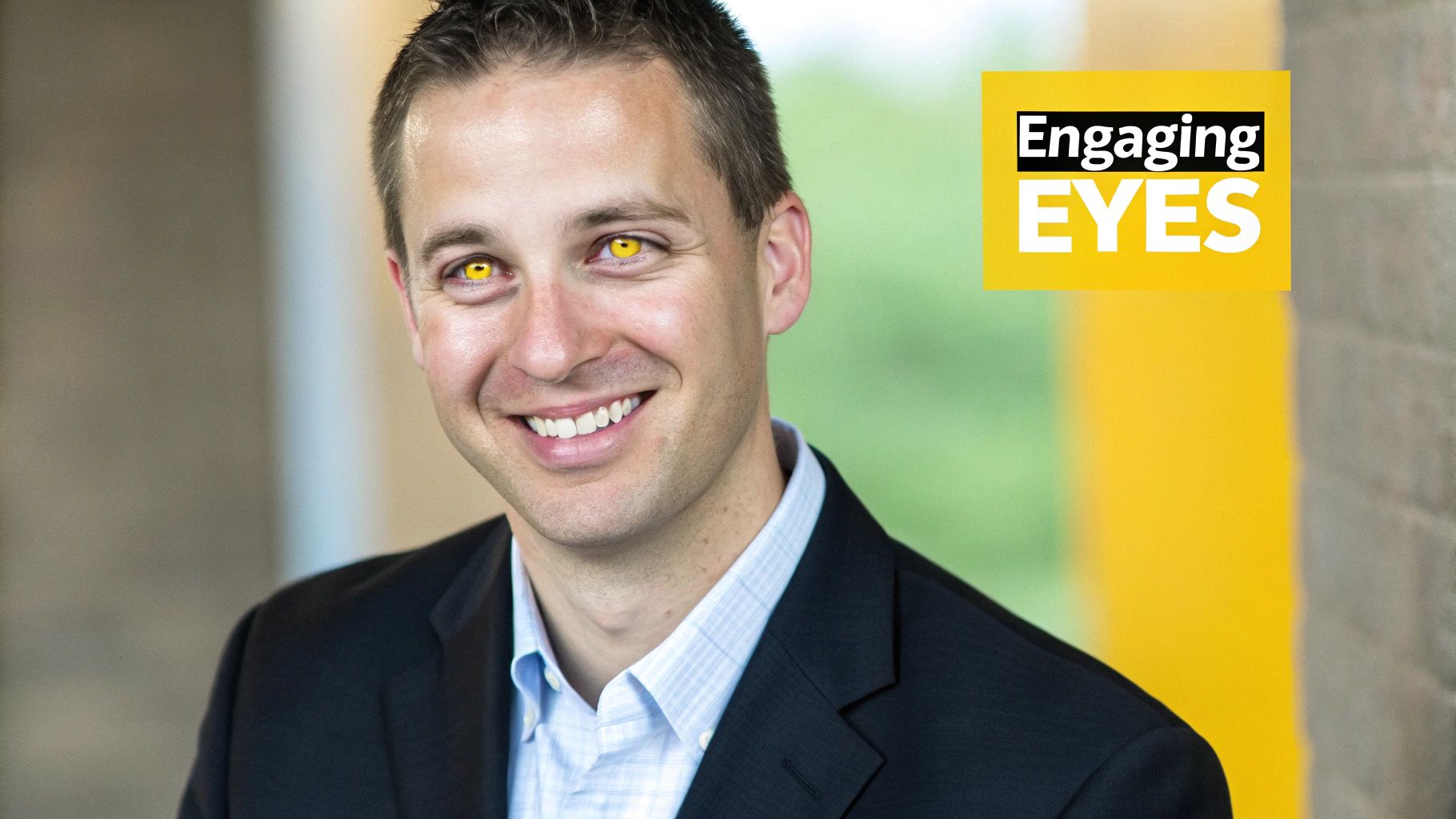
The Power of a Confident Gaze
Your expression conveys personality and intent. A forced smile can appear disingenuous, while a blank stare can seem distant. The most effective professional headshots capture a moment of authentic confidence.
Think of how medical professionals use warm, reassuring smiles to appear trustworthy. Their expressions are strategic tools that communicate competence and build an immediate connection. This principle is vital whether you're working with a photographer or using an AI service to generate a headshot that accurately reflects your professional brand.
Perfecting Your Professional Look
Achieving a natural and impactful expression requires practice. An authentic look feels genuine because it is rooted in real emotion. The goal is to look comfortable and in control, as if you are about to engage in a positive conversation.
Here are some practical tips to help you master your expression:
- Practice in a Mirror: Before your session, practice different smiles and expressions to see what feels most natural.
- Think of Something Positive: Genuinely think about something that makes you smile. This will create an authentic expression that reaches your eyes.
- Focus on the Lens: Treat the camera lens as the eyes of the person you want to connect with. This creates powerful, direct eye contact.
- Relax Your Jaw: Avoid clenching your teeth, which can create tension in your face. Let your jaw hang loosely for a more relaxed appearance.
- Try a Subtle Squint: Gently squinting your lower eyelids just a fraction can project confidence and focus.
4. Perfect Your Posture and Body Language
While a headshot focuses on your face, your posture and body language communicate confidence and authority. The way you hold yourself, even just from the shoulders up, significantly impacts the overall impression. Proper positioning is a key differentiator in professional headshots, transforming a simple photo into a powerful statement. This non-verbal communication is crucial for what makes a professional photo, whether traditionally shot or AI-generated, feel authentic.
The Power of Confident Positioning
The goal is to project a presence that is both strong and open. Slumped shoulders can suggest a lack of confidence, while good posture communicates self-assurance. It’s about more than just standing up straight; it’s about inhabiting your space with intention. This intentionality sculpts the lines of your neck and shoulders and creates a more dynamic final portrait.
Think of the official portraits of public figures or corporate leaders. Their posture is consistently upright and open, projecting authority without appearing rigid or unapproachable. This is a deliberate choice to ensure their body language aligns with their professional reputation.
Mastering Your Pose for Success
Achieving a powerful yet natural stance requires conscious effort. You can convey professionalism through subtle adjustments. Understanding these techniques is valuable whether you're in a studio or uploading photos to an Generator for AI headshots like Headyshot, as your starting posture influences the final result.
Here are some practical steps to perfect your pose:
- Align Your Spine: Before the shoot, stand with your back against a wall to understand what an aligned spine feels like. Try to replicate this feeling in front of the camera.
- Elongate Your Neck: Envision a string attached to the crown of your head, gently pulling you upward. This classic technique helps lengthen your neck and straighten your back.
- Angle Your Body: Avoid facing the camera head-on. Instead, angle your body slightly away from the lens and then turn your face back toward it. This creates a more dynamic and flattering look.
- Manage Your Shoulders: Keep your shoulders down and relaxed. Gently push them back and down to open up your chest, which communicates confidence.
5. Select the Right Background
The background of your headshot does more than fill the space; it provides context and ensures the focus remains on you. A well-chosen background complements your appearance and professional brand without competing for attention. Whether you opt for a classic studio look or a more dynamic environmental portrait, the right backdrop is a key component of an effective headshot.
The Power of Context and Simplicity
The goal of the background is to support the subject, not overshadow it. A simple, non-distracting background helps viewers connect with you directly. The choice between a solid color, a subtle texture, or an office environment depends on your industry and personal brand. For example, a tech entrepreneur might use a blurred modern office setting, while a lawyer may prefer a traditional dark gray.
Think of the profile photos you see from leaders in your field. Corporate executives often use neutral, soft-focus backgrounds to appear approachable yet authoritative. This deliberate choice ensures the headshot is versatile and can be used across various platforms, from a company website to a LinkedIn profile.
Choosing a Background That Works for You
Selecting the right background is a strategic decision. AI-generated headshots offer the flexibility to experiment with various backgrounds, allowing you to find the perfect match for your brand without needing a physical studio.
Whether working with a photographer or using an AI service, consider these practical tips:
- Avoid Busy Patterns: Steer clear of distracting patterns or logos that pull focus away from your face. Simplicity is key.
- Create Contrast: Choose a background that is a few shades lighter or darker than your attire. This creates a natural separation and makes you stand out.
- Consider Your Industry: A creative professional might use a textured background, while a finance professional would benefit from a clean, classic backdrop.
- Maintain Distance: If in a physical shoot, ensure there is enough space between you and the background. This allows for a soft, blurred effect (bokeh) that keeps the focus on you.
6. Consider a Professional Photographer
While smartphone cameras and AI technology offer convenient alternatives, hiring a professional photographer remains a valuable option for a truly customized headshot. A professional brings expertise in lighting, composition, posing, and post-processing. A photographer offers not only high-end equipment but also the ability to direct you in real-time to capture your most confident and authentic self.
The Power of Expert Direction
The primary advantage of a professional photographer is their ability to see what you cannot. They understand how subtle shifts in posture and expression can transform an image. They create a comfortable environment that helps you relax, resulting in a more natural and engaging portrait.
Consider the polished, impactful headshots you see on the websites of major companies. These images are often the result of a collaborative process where the photographer’s technical skill and artistic vision merge with the subject's personality to create a powerful, professional statement.
Finding the Right Photographer for Your Needs
Choosing the right professional is crucial. To ensure a successful session, it’s important to do your research and communicate your goals clearly. Here are some practical tips for selecting and working with a photographer:
- Review Portfolios: Look at a photographer's portfolio to ensure their style aligns with your industry and personal brand. Look for consistency in quality and lighting.
- Read Client Testimonials: Check reviews on their website or professional networks. Feedback from past clients provides insight into their process.
- Discuss Your Goals: Have a clear conversation about the intended use of your headshot, whether it’s for LinkedIn, a corporate website, or a speaker bio.
- Inquire About the Process: Ask about their retouching services, turnaround time, and what is included in their packages.
7. Plan for Professional Hair and Makeup
Professional grooming for a headshot is not about creating an unrecognizable version of yourself. Instead, its purpose is to polish your natural appearance, ensuring you look confident and professional under bright studio lights. This step is useful for managing shine, evening out skin tone, and defining your features in a way that translates well to a two-dimensional image.
The Power of Camera-Ready Polish
The intense lighting used in professional photography can accentuate skin imperfections and create unwanted shine. Professional makeup artists use specific techniques to counteract these effects, ensuring your skin looks smooth and natural. Similarly, a professional hairstylist can tame flyaways and create a style that looks neat and complements your facial structure.
This level of preparation is standard for corporate executives and public figures whose images must project credibility. By investing in professional grooming, you ensure that minor distractions don't pull focus from your confident expression. This preparation is just as relevant when taking photos for AI-generated headshots, as the AI uses your source photos to create the final polished image.
Tips for Grooming Success
Coordinating your grooming with your photo session is key to looking your best. Proper planning ensures you arrive at your session feeling confident, allowing you to focus on your expressions and posing.
For those preparing for a photo session, here are some practical tips:
- Schedule Smart: Arrange for a haircut a week before your shoot. For makeup, plan for it to be completed shortly before your session begins.
- Define Your Look: Communicate your professional goals clearly. Explain your industry and the image you want to project (e.g., approachable, authoritative).
- For Men: Professional grooming is for everyone. Consider a fresh haircut a few days prior, a clean shave on the day of the shoot, and a light anti-shine moisturizer to control glare.
- Keep It Timeless: Opt for a hairstyle that is classic and won't look dated in a few years.
- Prepare for Touch-ups: Bring essentials like translucent powder or a comb for minor adjustments during longer sessions.
7 Essential Headshot Tips Comparison
| Item | Implementation Complexity | Resource Requirements | Expected Outcomes | Ideal Use Cases | Key Advantages |
|---|---|---|---|---|---|
| Understand Good Lighting | High - technical setup, controlled space needed | Professional lighting equipment, studio space | Polished, consistent, flattering headshots | Studio and formal portrait sessions | Precise lighting control, reduces shadows, professional quality |
| Choose Appropriate Professional Attire | Medium - selecting and fitting proper wardrobe | Investment in appropriate clothing | Enhanced credibility and visual harmony | Any professional industry headshots | Conveys professionalism, complements brand identity |
| Master Facial Expression and Eye Contact | Medium - requires practice and coaching | Minimal, mostly effort and guidance | Confident, approachable, engaging appearance | Interviews, networking profiles | Builds trust and connection, increases engagement |
| Perfect Your Posture and Body Language | Medium - conscious effort and coaching | Minimal; possibly coaching | Confident, competent appearance | Executive and leadership portraits | Projects confidence, improves flattering composition |
| Select the Right Background | Low to Medium - choosing and setting up backgrounds | Low to medium - backdrop materials or location | Clean, focused, professional look | Wide variety of professional headshots | Reinforces branding, controls background distraction |
| Consider a Professional Photographer | High - coordinating scheduling and costs | High cost; requires professional photographer | Consistently high-quality, expertly produced headshots | All professional or high-impact headshots | Expert guidance, professional equipment, retouching |
| Plan for Professional Grooming | Medium - scheduling and coordinating stylist | Additional cost and time for stylists | Polished, camera-ready appearance | High-visibility portraits, media work | Enhances natural features, reduces post-processing |
If you want to find out more about headshots and photography, check our article What is a Headshot in Photography?
Your Professional Image, Modernized
Your professional headshot is a strategic asset. It serves as your digital first impression, communicating your competence and personal brand before you ever say a word. By mastering the fundamental elements we've explored—from lighting and attire to expression and background—you take control of that narrative.
Remember, the goal is not to create a stiff, overly corporate portrait but to capture the best version of your professional self. Authenticity is key. Your headshot should reflect your personality and be appropriate for your industry. The most impactful headshots are those that feel both polished and approachable, striking a balance that invites connection. These tips for headshots for professionals are designed to empower you to achieve that result.
Key Takeaways for a Flawless Headshot:
- Preparation is Paramount: Success begins before you get in front of the camera. Plan your attire, groom carefully, and get a good night's sleep. Beyond professional styling, a strong foundation starts with healthy skin; consider these tips for building an effective skincare routine to ensure you look radiant.
- Communicate with Confidence: Your posture, expression, and eye contact are non-verbal cues that speak volumes. Practice a genuine smile, maintain an upright yet relaxed posture, and connect with the camera.
- Control Your Environment: Whether you hire a professional or take your own photos, the technical details matter. Ensure your lighting is soft and flattering and your background is clean and non-distracting.
By internalizing these principles, you become the active director of your professional brand. This investment of time and effort pays dividends across every professional platform, from your LinkedIn profile and company website to your speaker bio. A great headshot opens doors, reinforces credibility, and ensures that your first impression is a memorable one.
Ready to create a stunning, professional headshot without the time and expense of a traditional photoshoot? Headyshot uses advanced AI to transform your casual photos into hundreds of studio-quality headshots. Elevate your professional image in minutes by visiting AI Headshots from Headyshot today.



